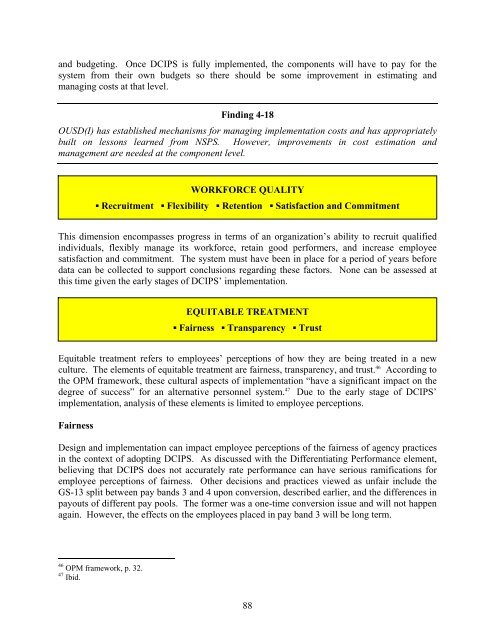Report - Government Executive
Report - Government Executive
Report - Government Executive
You also want an ePaper? Increase the reach of your titles
YUMPU automatically turns print PDFs into web optimized ePapers that Google loves.
and budgeting. Once DCIPS is fully implemented, the components will have to pay for the<br />
system from their own budgets so there should be some improvement in estimating and<br />
managing costs at that level.<br />
Finding 4-18<br />
OUSD(I) has established mechanisms for managing implementation costs and has appropriately<br />
built on lessons learned from NSPS. However, improvements in cost estimation and<br />
management are needed at the component level.<br />
WORKFORCE QUALITY<br />
▪ Recruitment ▪ Flexibility ▪ Retention ▪ Satisfaction and Commitment<br />
This dimension encompasses progress in terms of an organization’s ability to recruit qualified<br />
individuals, flexibly manage its workforce, retain good performers, and increase employee<br />
satisfaction and commitment. The system must have been in place for a period of years before<br />
data can be collected to support conclusions regarding these factors. None can be assessed at<br />
this time given the early stages of DCIPS’ implementation.<br />
EQUITABLE TREATMENT<br />
▪ Fairness ▪ Transparency ▪ Trust<br />
Equitable treatment refers to employees’ perceptions of how they are being treated in a new<br />
culture. The elements of equitable treatment are fairness, transparency, and trust. 46 According to<br />
the OPM framework, these cultural aspects of implementation “have a significant impact on the<br />
degree of success” for an alternative personnel system. 47 Due to the early stage of DCIPS’<br />
implementation, analysis of these elements is limited to employee perceptions.<br />
Fairness<br />
Design and implementation can impact employee perceptions of the fairness of agency practices<br />
in the context of adopting DCIPS. As discussed with the Differentiating Performance element,<br />
believing that DCIPS does not accurately rate performance can have serious ramifications for<br />
employee perceptions of fairness. Other decisions and practices viewed as unfair include the<br />
GS-13 split between pay bands 3 and 4 upon conversion, described earlier, and the differences in<br />
payouts of different pay pools. The former was a one-time conversion issue and will not happen<br />
again. However, the effects on the employees placed in pay band 3 will be long term.<br />
46 OPM framework, p. 32.<br />
47 Ibid.<br />
88













